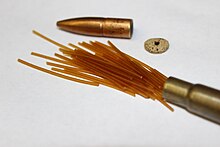Firearm propellant

Firearm propellants are a specialized type of
History
The oldest gun propellant was
Mechanism
When a propellant is ignited and begins to
Due to the relatively short distance a gun barrel can offer, the
Characteristics
The performance characteristics of a propellant are greatly influenced by its grain size and shape, because the specific surface area influences the burn rate, which in turn influences the rate of pressurization. Short-barrel firearms such as handguns necessitate faster-burning propellants to obtain sufficient muzzle energy, while long guns typically use slower-burning propellants. Propellants are typically manufactured in grains of geometric shapes to physically control rate of gas production in accordance with Piobert's law.[3] Shotgun and handgun propellants may be flakes, while Improved Military Rifle propellants were extruded as short cylindrical tubes, and ball propellants are small spheres.[4]
Types of propellant
- Black powder
- Smokeless powder
- Cordite
- Brown powder
References
- ISBN 0913022-00-4.
- ^ Smith, Selwyn D. (1965). Interior Ballistics of Guns. Washington DC: United States Army Material Command. pp. 1–2.
- ISBN 978-0854041275.
- ISBN 0-935632-10-7.
